The Hidden Costs of Live Chat: Why Small Businesses Can Encounter More Problems Than Solutions
Know the pros and cons of live chat. See how to avoid live chat issues and provide better communication with texting instead.

In the age of expectations for quick and even instant communication, small businesses often first look to live chat as a golden solution. Live chat has been a mainstream tool for small businesses for over a decade now. The hope is to connect with prospects and customers in real time, to enhance customer service and boost sales.
However, beneath the surface of this customer engagement tool lies a myriad of hidden challenges that can lead to more problems than solutions.
From unmet customer expectations to overwhelming demands on staff, live chat can inadvertently strain resources and diminish the very customer satisfaction it aims to improve.

It’s a nuanced reality facing small businesses as they navigate the complexities of using live chat. Sometimes the tool fails to make life easier for their teams or live up to the expectations of their customers.
All hope is not lost for great real time communication though. We’ll outline how to avoid these chat pitfalls. You also have a real-time alternative to live chat you can and should deploy.
Small businesses can realize additional benefits by using the number one communication channel instead, SMS.
Consumers want real time help but dislike the typical live chat experience
Consumers desire the ability to connect with a business fast. Trading emails, making a phone call, or leaving voicemails isn’t preferred for many. They often use live chat when offered. Satisfaction isn’t a given though, as a recent survey from Kayako showed 47% of consumers haven’t had a positive live chat experience in the last month.
The survey also showed that 40% of consumers are not confident they’ll get the support they need in a reasonable amount of time with live chat.
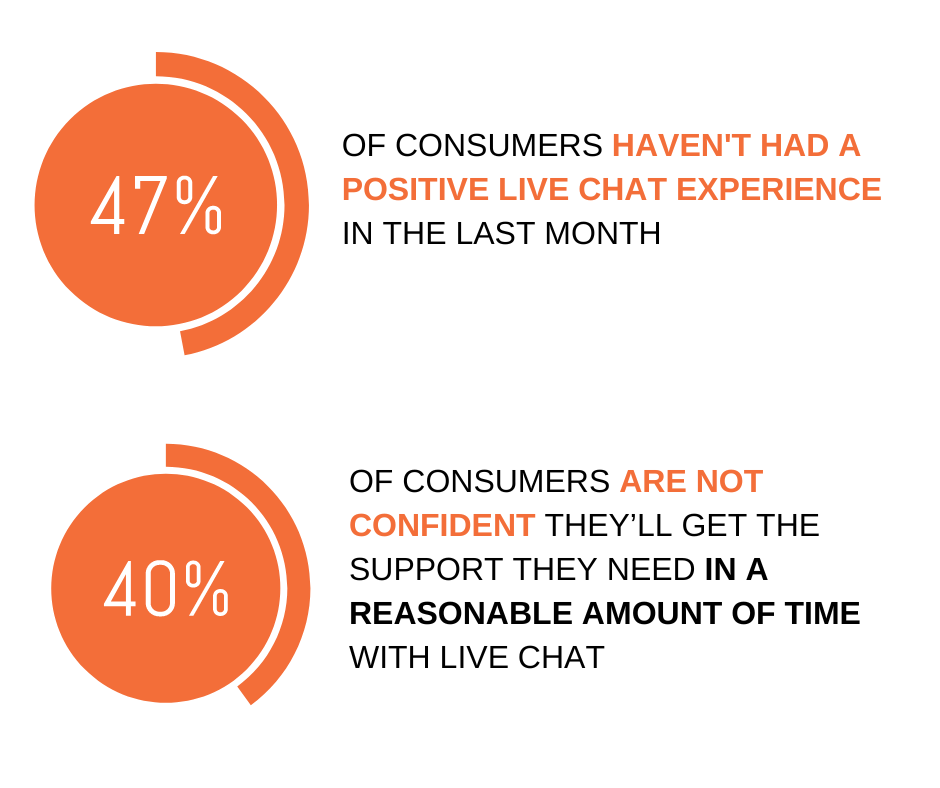
Why so high? There are a number of challenges, enough that it’s not a preferred channel for many. What are the main live chat disappointments for consumers?
Poor user experience
Poor user experience can be attributed to a combination of things. One thing that stands out on it’s own is that live chat is a bit of an island. You only use it on websites and there are literally hundreds, if not thousands of live chat tools available.
Consumers expect the experience to be like messaging tools they already use daily like SMS, iMessage, and Facebook Messenger. It’s often not.

The combination of limited experience and a wide variety of tools that each can have their own little interface and experience nuances can easily lead to frustration. If users have to learn on the fly while trying to get help, it’s not the best experience.
Live chat is also not mobile. Yes, it works on a smartphone, but mobile in this case means you can’t take always your chat with you. Start a chat on a desktop but need to head to a meeting or run an errand? You have to leave or end the chat. Start a chat and they don’t have an agent available? You have to provide your email and the conversation moves to a channel you likely were trying to avoid.
Waiting, waiting, and waiting
Live chat represents real-time help, so waiting for a chat agent to help you can make minutes feel like hours. That frustration can build quickly as the seconds and minutes tick by.
Studies have shown an average of 160 seconds for live chat replies, coming close to 3 minutes. While that timing might be pretty good compared to email, consumer expectations are pretty high to get help in just seconds with chat. That puts businesses in a tough spot to meet or exceed expectations. you have just minutes.
Lastly, the wait can be forever. The study found that 20% of chats were not responded to at all. That number is alarming, but as we share further, you’ll learn why it happens.
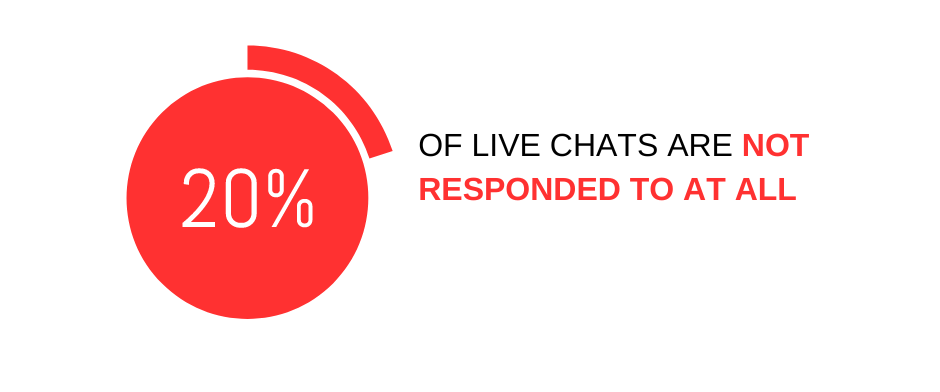
Scripted responses
Most live chats start because the consumer has a quick question or a specific question they want answered. When questions are replied to with a scripted response, the consumers isn’t pleased.
29% of consumers listed scripted responses as their top frustration with live chat. The use of chat bots has only added to this frustration as many tools can miss the context or detail of the customers need and give a very general answer.
When live chat is used to get a human to help you over the static content of the website, getting static replies as an answer or links to web content isn’t meeting their needs.
Live … but dead
You want quick help, you see the live chat buttons on the screen and click. The chat window opens and then the message of “offline” appears or you learn that no agents are available. It’s hard enough to get someone to take action once, much less to come back again later.
These offline and agent not available statuses can deter customers and prospects from contacting you and likely to seek another company to contact.
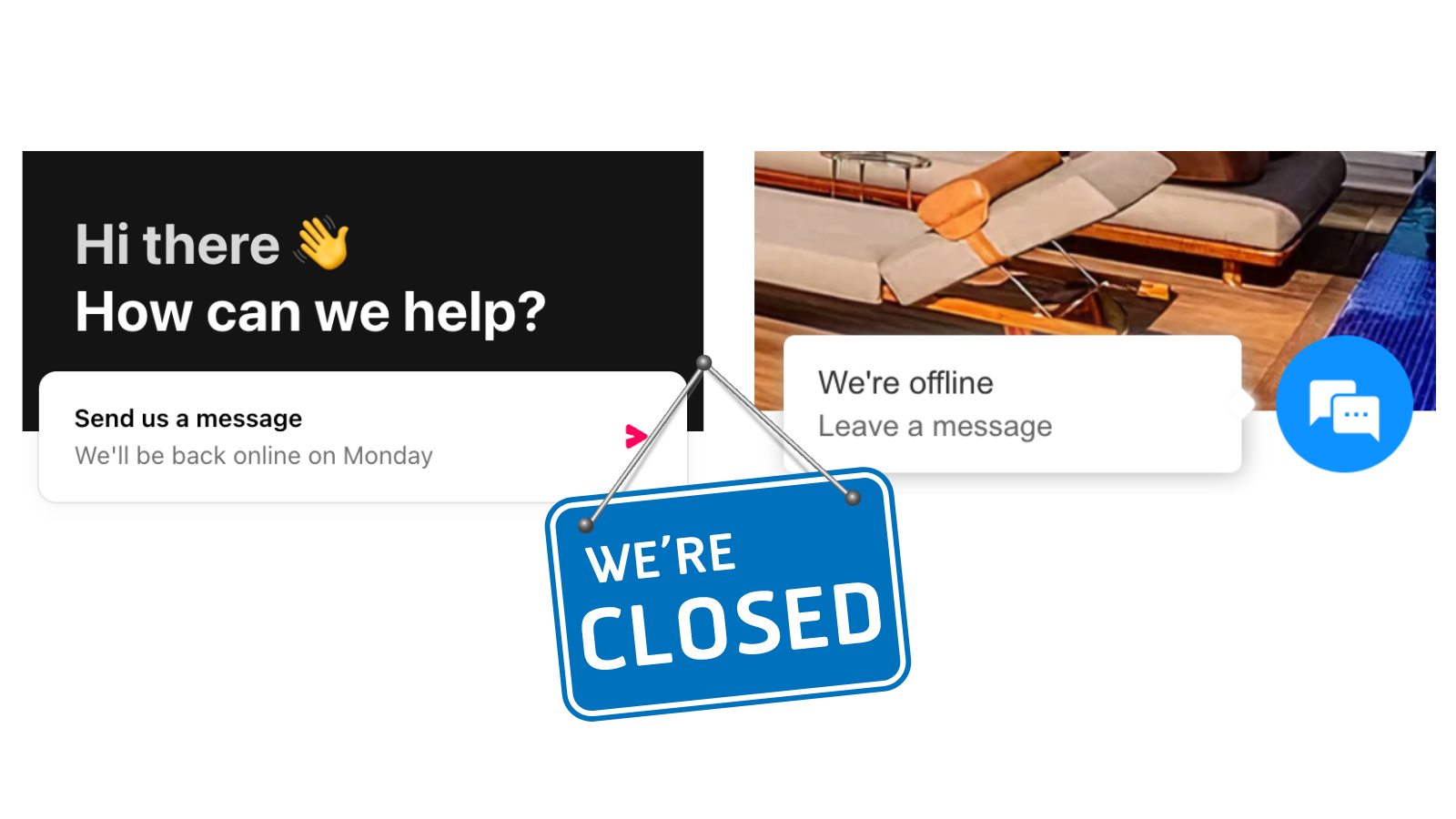
Because of live chat’s demands, staffing it to be available for extended hours is difficult. Some businesses even go as far as paying for an outside service to staff their live chat, but then lose out on having their own team, knowledge, and experience available to answer questions.
We conducted a survey of 2,000 consumers and found that 57% of respondents would leave the website when encountering a live chat that is “offline”. That is a VERY leaky conversion funnel that is wasting your marketing dollars and opportunities.
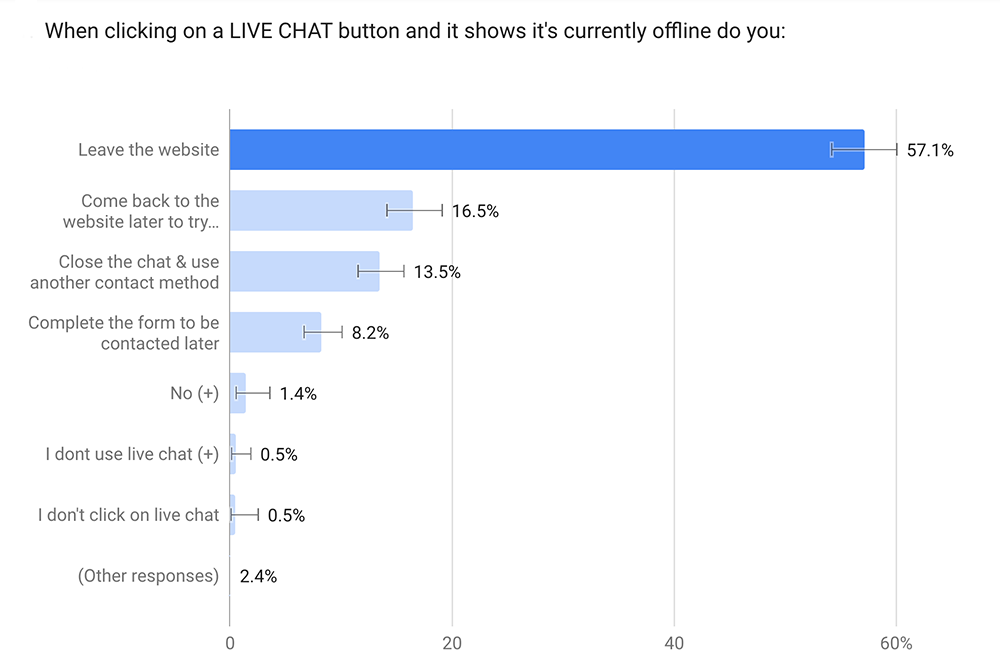
Here is a personal chat experience I recently had as an example. I needed to contact the battery manufacturer for my small solar system.
Their website had a chat icon, but after I started the chat to ask my question at 8:28am that morning (a weekday), their reply let me know I wouldn’t get a live chat reply. I would be getting an email reply “as soon as possible”.

That email reply to my one question arrived in my inbox 12 hours later at 8:31pm that night. I wanted help in minutes that they led me to believe I could get, but got it 12 hours later in a channel I didn’t prefer.
Live chat is hard for a business to master
For the business, there are two main pain points that live chat brings to the table.
The first big challenge is that live chat is synchronous vs asynchronous like email or texting. This means you need to stay in a dedicated session to send or receive messages (both sides of the conversation).
For most staff, managing a live chat requires your full dedication just like a phone call would. That doesn’t scale or make work more efficient.
The second challenge is that businesses activate or train very few of their staff to manage their live chat solution. It’s very common for a small business to just have one or two users with access to manage chats since it takes the right person to handle the real-time pressure chat can bring. That’s not enough coverage.

The combination of synchronous conversation, the pressure of real time, and needing to be available within seconds of a chat starting compound with live chats being understaffed.
Tips to be successful with live chat
There are things you can do to make live chat work for your business and avoid the issues. Those that are successful with live chat have planned, made decisions, and supported their strategy.
1- Be fully committed
Just having one team member to manage your chat is not commitment. Neither is not caring about reply times. To be successful with live chat you need to prioritize it and be committed in resources, performance, and experience.
Treat live chat as a valuable communication channel, or you’ll never get it to be one. Live chat needs the support of the right resources to deliver for your business.
2- Only show live chat when it’s available
As noted above, don’t bait and switch your website visitors. It can be a very harsh jump from them feeling “great I can get quick help” to “this isn’t available, you have to use email”.
Know if your live chat solution has the settings you need to not disappoint prospects or customers with an unavailable live chat or agents.
3- Review, optimize, and improve
Manage your live chat performance like an ad campaign. You should be reviewing the analytics from your chats to see where you have opportunities to improve.

Time to first reply, overall reply times, conversion or success rates and more can and should be analyzed and discussed to keep improving the chat performance and outcomes. Consumer expectations are high for fast live chat reply times so create and support a process to make that happen.
A better solution than live chat? It’s texting
The option of a real-time solution that better meets the challenges live chat presents for both sides is web-to-text. It’s a real-time channel that consumers highly prefer and that your business and team can better staff and manage.
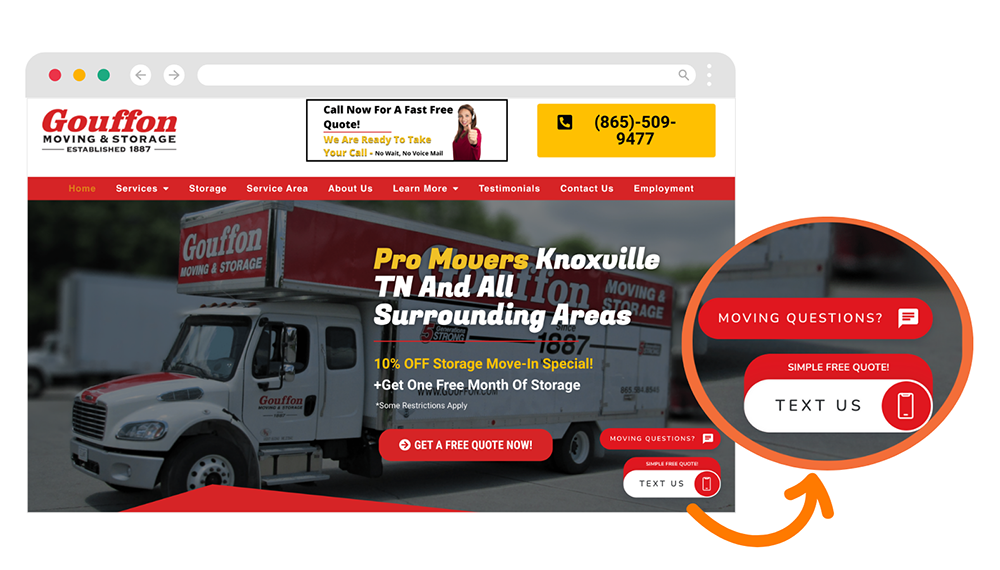
By offering your website visitors the ability to start a SMS chat with you, from any device, you can exceed expectations for your customers while your team can manage the channel without stress.
Text messaging has risen to many consumers top channel for communication. Our survey found that texting at 37.6% topped phone calls (30.2%) and almost doubled email (19.6) as a preference.
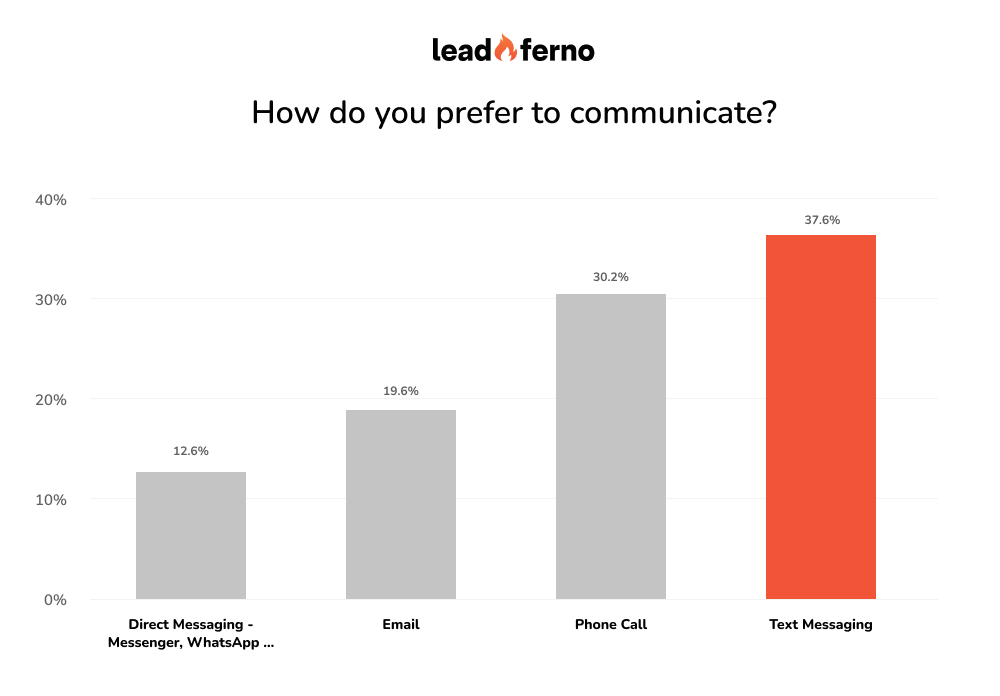
Texting is a better experience
The challenges we outlined with the live chat experience for consumers are not present when offering texting. Consumer’s most used app on their phone is their SMS app. This makes it familiar, easy, and mobile since they can move through their day and get messages.

A massive benefit is that they get a push notification of any new text message or reply so they don’t have to stay engaged or check back for new messages. They get an alert they are used to.
Lastly, texting is never “offline” and doesn’t need to default to another channel like live chat does to email. If a prospect or customer texts you after hours you can still text them back when you become available. In using a texting platform like Leadferno you can use auto-replies to set expectations on getting a reply.
Texting is easy to manage
Adding 2-way texting to your communication channels is good for your team too.
First, the adoption for your team is easy. Your entire team already knows how to text and this allows you to have more of your staff helping customers. If you are using a business texting tool like Leadferno, now you are giving them texting plus a huge set of features that makes it easier and faster to engage.
With SMS being asynchronous you gain efficiency too. In the same time as handling a phone call with one prospect, they could be managing 6 to 10 text conversations. The same can be true versus live chat as the instant communication requires more of a solo focus like a phone call.

Minimal training, better features, staffing expansion, and you can exceed expectations (hours vs. minutes) are all huge benefits. A huge bonus for your business is that this communications is all centralized in a secure app you control, manage, and can report on.
You create a connection
SMS gives you a personal, super-powered connection to your prospects and customers. With live chat, you get to help a customer in that moment, just for that session. With 2-way texting you can help them now and also reach back out at to them anytime.
That connection gives you the benefits of faster reply cycles, builds your owned media, and can power the entire customer lifecycle – prospect, sales, service, utility, and feedback/reviews.
Get real-time communication right
There is no doubt that communication is evolving and businesses need to add real-time channels to their communication offering. Choosing the right one based on your staffing, commitment, and consumer expectations is key to being successful with it.
Similar posts you may be interested in:

Get our monthly update covering SMS, messaging, and Leadferno features.